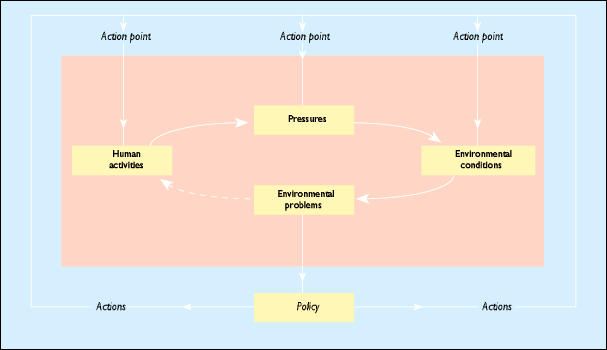1 Reporting on Europe's environment
Explains how the report has been developed and
organized and the functions it fulfills. The coverage, constraints,
information selection and assessment methods used are presented and
discussed. The report model (see illustration) shows the analytical
structure of the report and specifies the interrelationships between
environmental assessment, policy making and implementation.
 |
The analytical model ot the report and its
relation to policy making and implementation. At its most simple, human
activities put pressure on the environment giving rise to environmental
problems. |
2 Environmental changes and human development
Provides the context for the assessment of Europe's
environment where human action is now altering the global environment
on an unprecedented scale. The interactions between environment and
development are examined in relation to changes in human induced
interferences with biogeochemical cycles. Demographic and economic
growth are key to understanding human-induced pressures on the
environment, and sustainability and carrying capacity are important
concepts against which to analyse these problems. Europe often plays a
disproportionate role in contributing to environmental change.
In the past 100 years, world population has tripled, the world
economy has grown 20 times, fossil fuel consumption has increased by a
factor of 30 and industrial expansion by a factor of 50 since the 18th
century 6 million km2 Of the world's forest — an area larger than
Europe — has been cleared world-wide as much sulphur and nitrogen is
cycled by human activities as by natural phenomena.
3 Europe: the continent
Europe is the second smallest continent, comprising
little more than 7% of the Earth's land area. The continent is
surrounded by nine major seas, including the world's two largest
land-locked seas, the Caspian and the Black Sea. The area includes 46
States, of which 19 are in the EU and EFTS area, 21 in Central, Eastern
and South-eastern Europe, four < small continental States and two
are small island territories. The continent spans three climatic zones:
the circumpolar, the temperate and the subtropical. The chapter
discusses these, and the geological and biogeographic factors that give
the continent its soil and vegetation patterns. It concludes with an
account of landuse in Europe.
- The proportion of European land devoted to agriculture varies from
less than 10% in Finland, Sweden and Norway, to more than 70% in
Hungary, Ireland, Ukraine and the United Kingdom
- Forest cover varies from 6% in Ireland to 66% in Finland
- Each decade 2% of agricultural land is lost to urbanization
- Europe is two to three times more densely populated than the United
States and Africa, but only half as much as Asia

Document Actions
Share with others